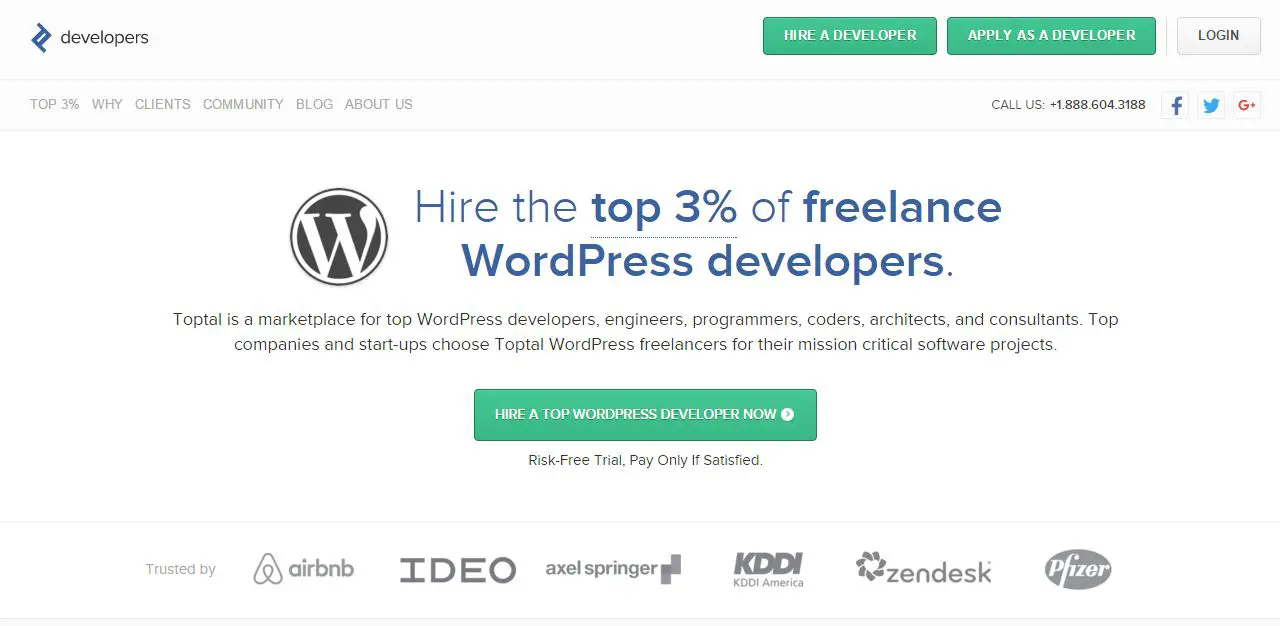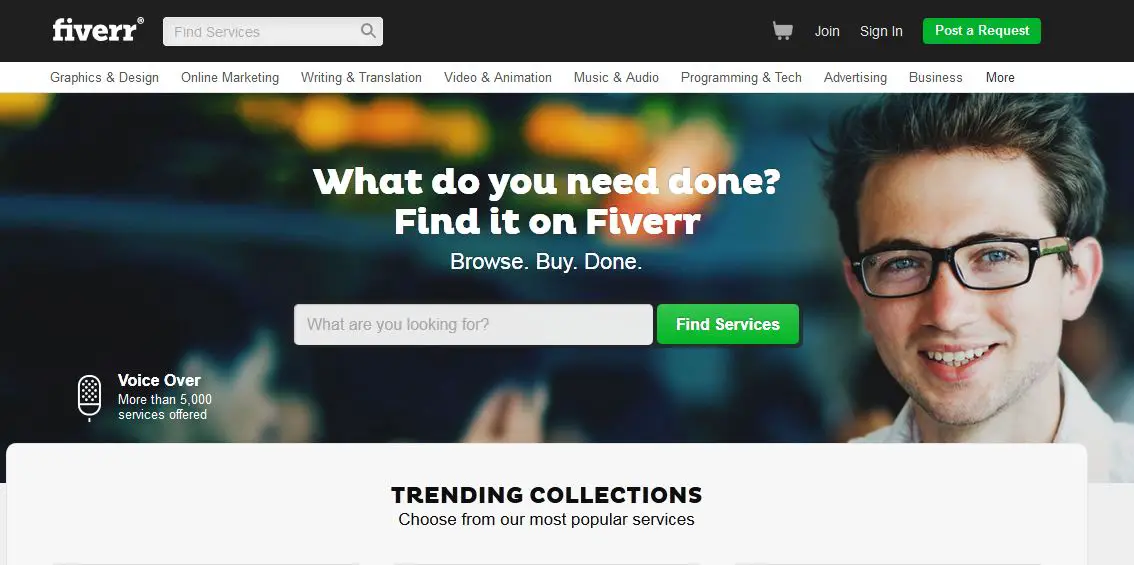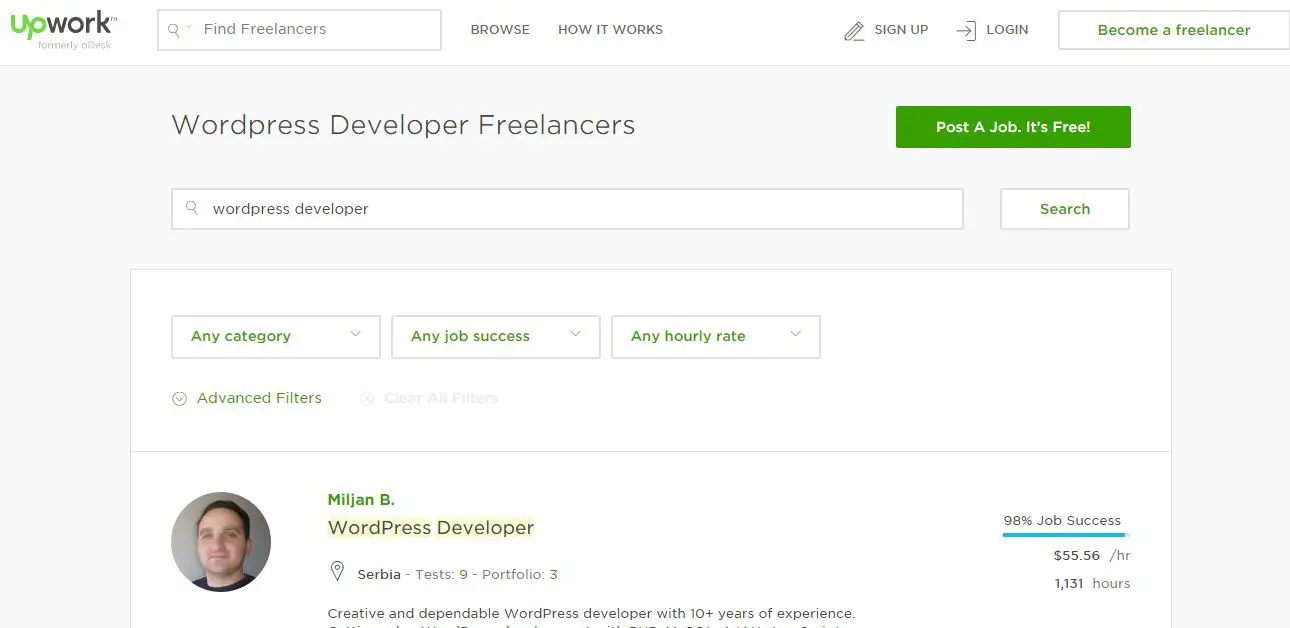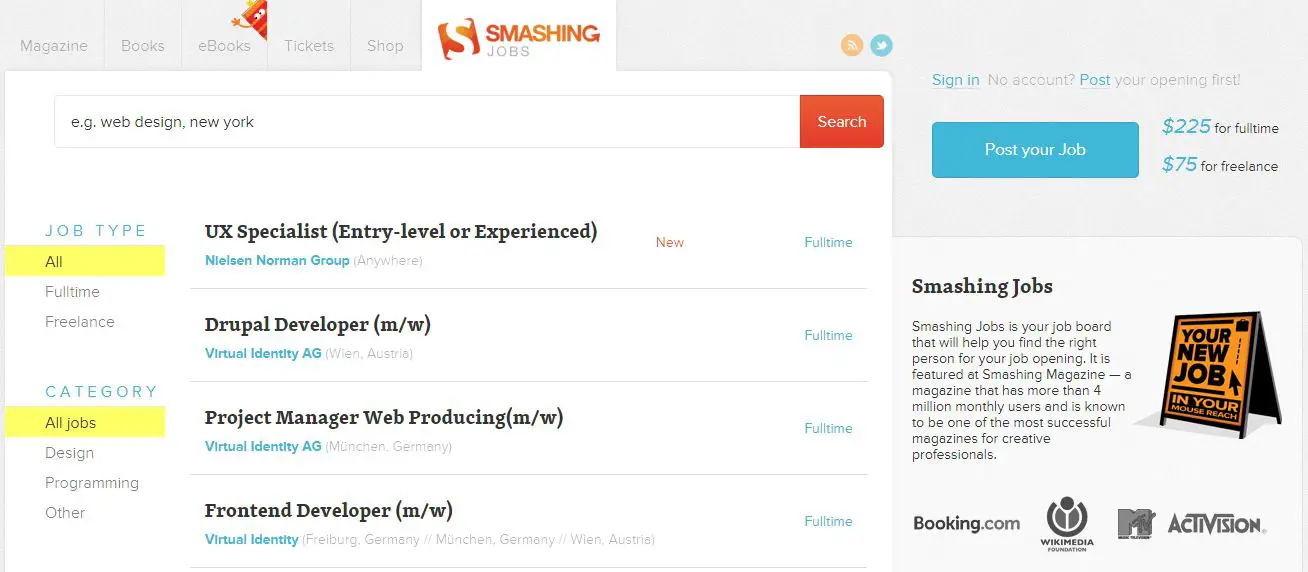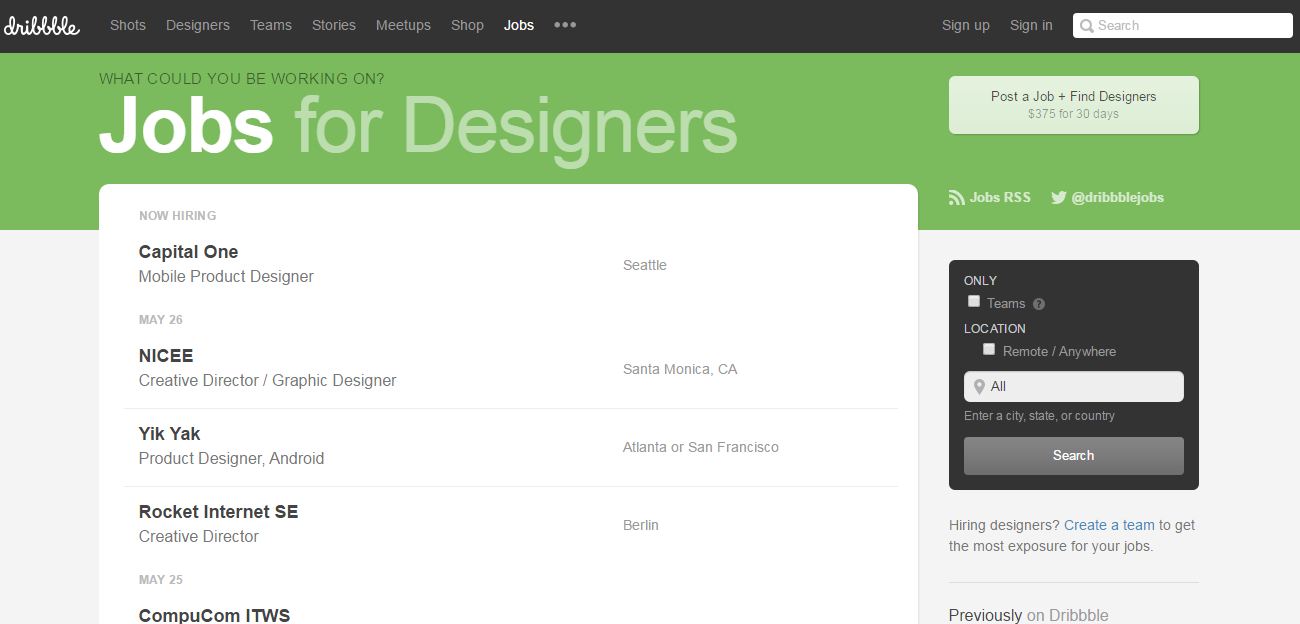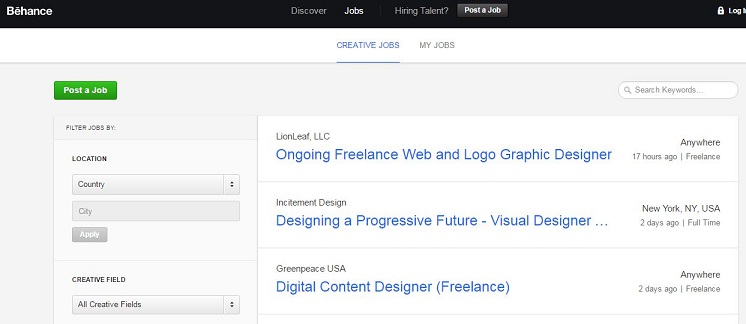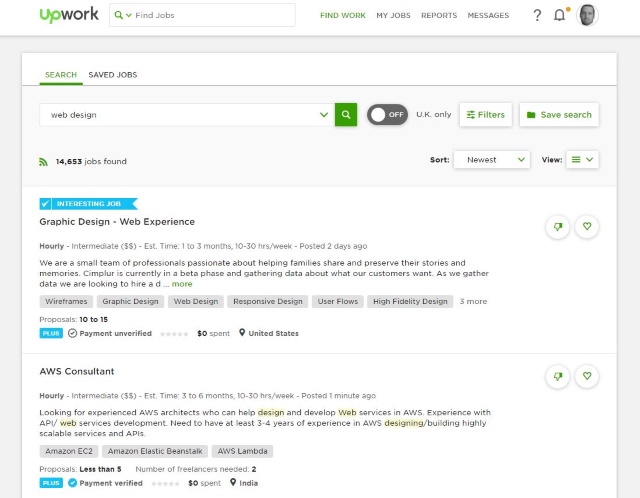
Why are some many people attracted to freelance web design jobs? The main attraction of working freelance web design jobs online is that this work offers you two types of freedom that most other 9 to 5 job can’t offer:
- Location freedom: Freedom to work from wherever you want.
- Time freedom: Freedom to work whenever you want.
At first glance, working as a freelance web designer may sound perfect. However, as with most things in life, there is also another side of the coin. You’ll need to find the right jobs that suit your skills, pitch the clients with attractive proposals and build a solid portfolio online. All that before you get paid anything!
{autotoc}
Freelance job boards
Another way to find freelance web design jobs is by looking at job boards. All you need to do then is find the job that matches your skillset, write a proposal and submit it to the employer for review.
Freelance job boards are less formal than marketplaces. They won’t have the process-driven setup like Upwork does or an escrow system. It will be up to you and the client to decide how to work, how deposits and payments are handled and how you’re going to tackle dissatisfaction and complaints.
Freelance job boards don’t take a cut of your earnings though!
Freelance Web Design Jobs 2026
After that brief intro, here are a few places that you can be sure to find good options for freelance web design jobs or other types of development jobs.
1. Toptal
When it comes to building your career as a freelance web designer, Toptal stands out from other platforms. Toptal features the top 3% of talent from around the world. It is an exclusive network of top talented web designers and engineers that are recognized for their expertise and paid accordingly.
If you’re a freelancer with plenty of experiences in web design, you should consider creating a profile and building a portfolio on Toptal. Not everyone who applies to join as a web designer will be accepted as a freelancer. Toptal conducts a rigorous screening process to identify the best applicants and typically fewer than 3% of applications are accepted.
Once you’re on the platform, you don’t have to spend any time finding clients, pitching to them, invoicing or any of that stuff. You will be contacted by clients, given a brief and just have to come up with a price. If you’re accepted on Toptal, 95% of your working hours are billable.
Let’s look at a fewmore freelancing job marketplaces.
2. Fiverr and Fiverr Pro
Fiverr is the world’s largest marketplace for small services. You can find various web design-related categories on Fiverr in which you can list your services for a price starting from $5. If you’re looking to earn some quick cash by working on small web design jobs, Fiverr might be the right choice for you.
Fiverr is a very good marketplace but at the lower end of the scale. Fiverr Pro is also a marketplace, but to get there you need to get approved. Only screen designers can get on this marketplace, but now instead of charging low prices, you can command whatever you think your services are worth.
Clients tend to predominantly want a lot of work for not a lot of money, but for Fiverr Pro they're used to paying more.
Fiverr is great if you’re a relatively new web designer but as soon as you have a few specializations under your belt, you will likely move away from Fiverr. It is harder to compete here on skill than price, which is where Fiverr Pro makes the difference when you're more established.
Below are a few job boards where you can find web designing gigs.
3. Upwork
Upwork is a freelancing marketplace originally conceived by combining two popular platforms Elance and Odesk, a while back. All you need to do is to create an account on Upwork, complete your freelancer profile and bid on jobs that fit your skillset with an appropriate proposal.
Upwork is huge and has a wide range of clients looking for web designers. There is a real mix on here, from low paid to well-paid and everything in-between. It’s a fast-moving marketplace so be prepared to spend a significant amount of time scouring the listings and pitching!
Given that we've just discussed both Toptal and Upwork, you may want to have a look at this article, to understand the difference between them.
4. Freelancer
Freelancer.com claims that they’re the world’s largest outsourcing platform.
Aside from bidding on the listed web design jobs, you can also find contests where you can compete with other web designers by submitting your work. Contests are a win-win situation for both you and employers. Employers get lots of different submissions to review whereas as a designer, you’ll be rewarded if your work is accepted.
If your work is not accepted, you don’t get paid.
Freelancer is a fast-paced freelance marketplace so you have to be on your toes and dedicate time to pitch and secure work. Otherwise, it is a good place to be a freelance web designer.
5. Smashing Magazine Jobs
Smashing jobs is integrated with the award-winning Smashing Magazine blog where you can find the right web design jobs that suit your skillset. There is a real variety there from basic UX design, graphic design to complete Joomla theme production and everything in-between.
6. Dribbble Jobs
As a web designer, you may already know about Dribbble. It is an online community where you can showcase your talent. It has also featured employers from some of the biggest brands such as Facebook, Microsoft, and Tumblr. Well worth checking out.
7. Behance JobList
Behance is an online community where you can showcase and discover creative works including web design. Behance JobList is a part of the Behance site that even allows you to find opportunities within some of the top global brands, including Google, Facebook, Sony, and others. You can search via company or category to help refine and narrow your results.
Finding freelance design jobs
One of the first things you’ll need to be doing as a web design freelancer is to find the right gigs that suit your skillset. If you are just getting started as a freelancer,, finding the right jobs requiring the right skills can be a tedious task. In most cases, finding those jobs and pitching the employers will be a non-billable task so you don’t even get paid for your efforts!
In this post, we’ll take a look at some of the best places to find freelance work that match your skills.
Top Tip: Many of the top web design blogs have a jobs section either on the main site or in their forums. Have a look at our full list of 101 web design blogs you need to follow so that you can identify the top blogs which have a section where freelancers can pitch their services or maybe get in touch with potential clients.
Second top tip: As a freelancer, you'll have to get used to competition. You won’t be the only person going after a job, especially if you are competing in popular marketplaces. Rather than trying to pitch for everything, you should specialize in a specific niche and compete in that field. Find something you are passionate about and carve yourself a spot. Expend every effort to become one of the best providers in that niche and you should find lots of work.

Specialization can be crucial
For example, if you work with WordPress, you may want to specialize in eCommerce. Maybe you can answer the WooCommerce vs Shopify question once and for all. Or are adept at solving particular problems in one platform or another.
You could even keep on niching and focus on building websites for service providers who take bookings via WooCommerce. This allows you to be able to get much more focused testimonials, have specific expertise and learn a specific niche inside out. This may narrow your field of prospective clients but will drastically increase your chances of closing specific deals.
Another niche you could focus on, and something for which there is ALWAYS demand, is increasing the speed of websites. You'll find the majority of non-developers have no idea how to speed up their website. They may know it’s now a requirement for good SERPS but have no idea how to achieve it. If you do know how to achieve faster loading times, there could be a lot of money in that!
Sticking with SEO for a moment, it is much easier to rank yourself and your portfolio in a specific niche than to rank for broader niches. This is a minor, yet powerful inducement to specialize.
In terms of where to find jobs, our primary suggestions would be the following:
- Niche marketplaces
- Freelance job marketplaces
Freelance Web Design job marketplaces
Freelance job marketplaces are prime real estate for finding freelance web design jobs. Competition is rife here and you will have to fight hard to get work. You do have to bid against other freelancers but will have a huge pool of jobs to choose from.
Building a web designer portfolio on a freelance marketplace is one of the best and probably the easiest ways to get started in your freelancing business.
Freelance job marketplaces are huge repositories of available jobs but they aren’t perfect. If the ability to work from home is what lures you to be a freelancer, you may also expand the pool and check out remote jobs on offer. Being a remote employee has its own advantages like not requiring you to save for tax like a self-employed freelancer would have to and a more steady income.
In your early days as a freelance web designer, finding the right web design jobs on marketplaces is one of the most tedious tasks you’ll need to work on. No matter how talented a designer you may be, unless you’re good at hunting down potential clients, you are much less likely to succeed as a freelancer.
Usually, you will have to undercut your prices until you can build a solid reputation for doing great work, then you can start charging your proper prices. As you build a proven track record, getting work will start to get easier.
In the beginning, you should be competing only for small jobs, so that you can win more of them. Negotiate with the buyer that you will give them great work in return for a good review.
Supportive ecosystem
Where freelance job marketplaces shine is in the infrastructure. You have a marketplace where you can bid for work. Clients pay into escrow when you begin the project. You submit your work through the marketplace and the client releases the funds.
The marketplace will take a cut but in return, you get a formal process for working and stand a much higher chance of being paid.
There are always troublesome clients the same way there are always troublesome freelancers. Marketplaces reduce that as much as possible by using the escrow system and by offering a review and arbitration system to handle disputes.
They are far from perfect and are skewed towards clients but they are better than nothing.
Non-billable work
When getting started you’ll need to spend a significant amount of time for non-billable activities like searching for the right jobs, assessing your fit, pitching for the job, interviewing, perhaps a paid test and only then do you get to work on the actual job itself.
Once you have a few successful projects behind you and some positive feedback from former clients, things become a little easier.
You can worry a little less about hunting down clients who could afford you as they will begin to find you. You will still need to get out there and pitch for projects but you should also find incoming inquiries coming your way too.
There is still work involved, but the burden gradually becomes lower and lower as you progress within a given marketplace.
Competition is rife
Freelance job marketplaces attract a lot of clients but also a lot of freelancers. You are going to have to get used to moving quickly and bidding fast on jobs if you are to secure one.
It’s a very competitive market and if you snooze, you really will lose.
The competition will often come from countries with very low living costs. If you join a freelance marketplace, you have just two viable options.
- Compete on price or
- compete on a USP that others cannot match.
The first option means you’re going to be working for next to nothing but will still be working. The second feeds into our second top tip above around specialization.
We would suggest that second route. Why work yourself to the bone when you could just work smarter? Find a niche, offer a service other freelance web designers cannot and sell that speciality hard.
Freelance Web Design Jobs Frequently Asked Questions
How do freelance web designers find jobs?
Freelance web designers typically create a network of people they can rely on to send them jobs often. By creating excellent work to their initial customers, they can start to get a lot of good referrals and repeat customers. Most especially, if they partner with a few large customers such as agencies or large corporations, they can expect a good source of jobs in the long-term. The hardest part of being a freelance web designer is finding the first few jobs to help create this network of referrals.
How do I become a freelance web designer?
To become a freelance web designer you'll need to well versed in web design. Ideally, you start your career by being employed in a software development company or marketing agency where you can hone your web design skills. As a side gig, you should start some web design work and building a network of clients and referral work. When you feel that you have enough side work, you can leave your fulltime work and start working as a freelance web designer. You can also use the options listed above to increase the network of referral work you get.
How much do freelance web designers charge?
The hourly rate freelance web designers charge can vary dramatically based on the experience, skillset, unique selling points, location, competition, and other variables. In the United States, one would expect a freelance web designer to charge anywhere between $40 to $150/hour. Outside of the United States, freelance web designers would charge less than these amounts.
Can you work from home as a web designer?
Yes, you can work from home as a web designer. Web design is one of those industries that is totally location agnostic. This means, that you typically only need a laptop and an internet connection (and web design skills) to be a successful web designer. Whether you work from home, from a co-working space, on-site, or traveling as a digital nomad is totally your choice as a web designer.
Is web design still in demand?
Yes, web design is still in demand and will continue to be for the foreseeable future. While the market itself is evolving with people possibly moving away from the typical WordPress site and using more page builders and evey products such as Wix and Squarespace, there is no doubt that freelance web design will be in demand. The bigger forces of the market are that many of these jobs are moving offshore, so this is the reality of the marketing you'll be competing in.
How to find web design jobs?
The best way to find web design jobs is through referrals. If you already have a small network of clients, and they are happy with your work, ask them to refer you to their own network so that you get better word of mouth and grow your network. Your second option would be freelance market places, but it is best to establish a local foothold first, becuase competition is very high in the marketpalces.
Wrapping Up : Freelance Web Design Jobs
Becoming a freelance web designer is a leap into the unknown and involves a lot of hard work, non-billable work and a ton of effort. In return, you get to work how you want, when you want, where you want.
The rise of the gig economy means a maturity of platforms and more clients who know how the system works. You will still have to filter out those clients who want something for nothing but there are hundreds, if not thousands of worthy clients out there willing to pay good money for your skills.
Good luck out there!
Know of any other freelance marketplaces or job boards? Have you made it as a freelance web designer? Tell us below if you do!

